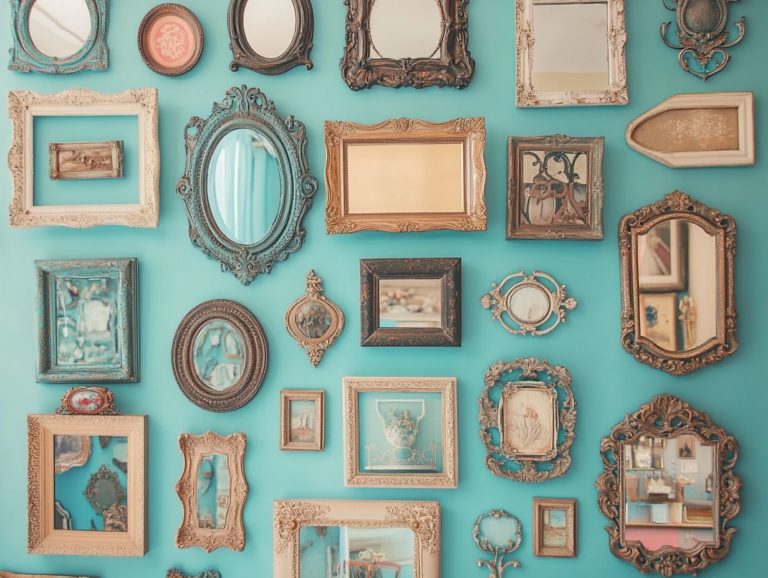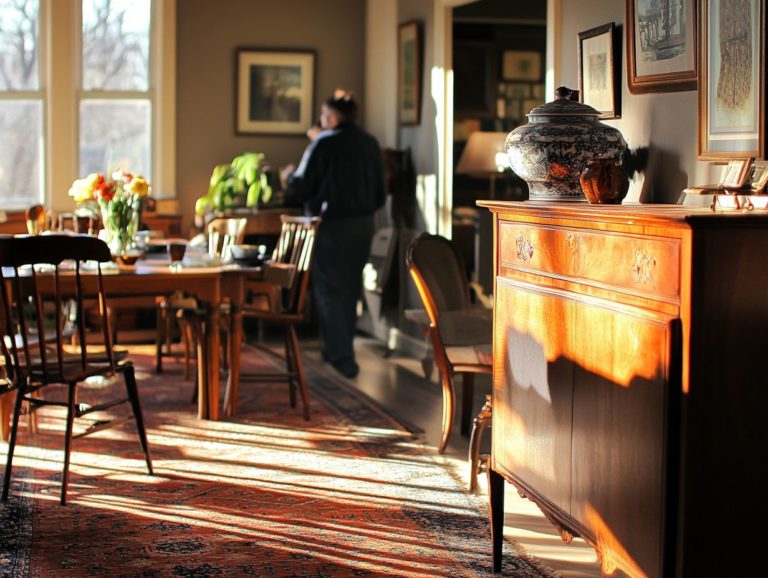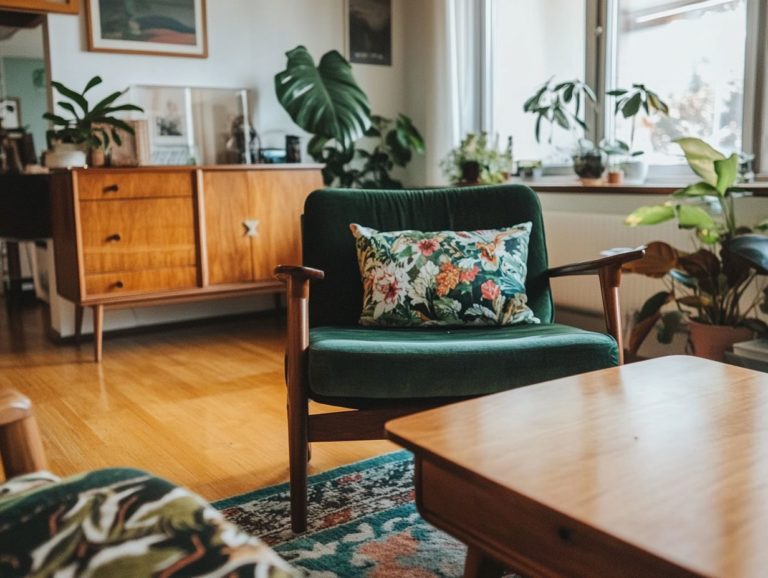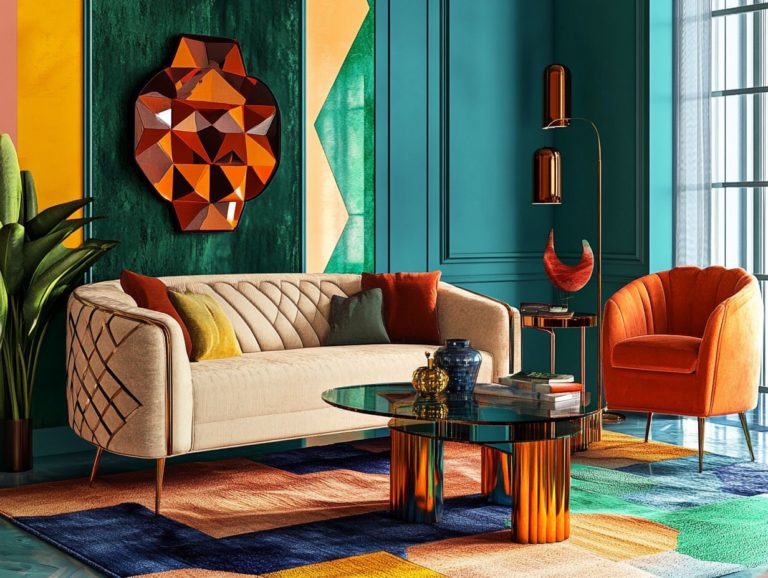Top 5 Vintage Furniture Brands to Look For
Vintage furniture possesses a distinct charm and character that often eludes newer pieces, making it a coveted choice for discerning homeowners and collectors alike. The allure of antique furniture increases its desirability in today’s market.
Discover the captivating history of vintage furniture that could inspire your next investment! This article offers compelling reasons to consider investing in it, along with insightful tips for identifying high-quality finds. These tips include understanding furniture quality and the various furniture styles available.
It also shines a spotlight on five prestigious brands celebrated for their exceptional quality and timeless designs, reflecting the evolution of furniture design through the ages. Whether you re a seasoned collector or just beginning your journey, learn how to expertly shop for, authenticate, and care for these invaluable treasures don t miss out on their unique stories!
Contents
- Key Takeaways:
- 1. The History of Vintage Furniture
- 2. Why Invest in Vintage Furniture?
- 3. How to Identify Quality Vintage Furniture
- 4. Top 5 Vintage Furniture Brands
- What to Look for When Shopping for Vintage Furniture?
- Frequently Asked Questions
- What are the top 5 vintage furniture brands to look for?
- What makes Herman Miller a top vintage furniture brand?
- Why is Eames considered a top vintage furniture brand?
- What sets Knoll apart as a top vintage furniture brand?
- Why is Broyhill a top vintage furniture brand?
- What makes Heywood Wakefield a top vintage furniture brand?
Key Takeaways:
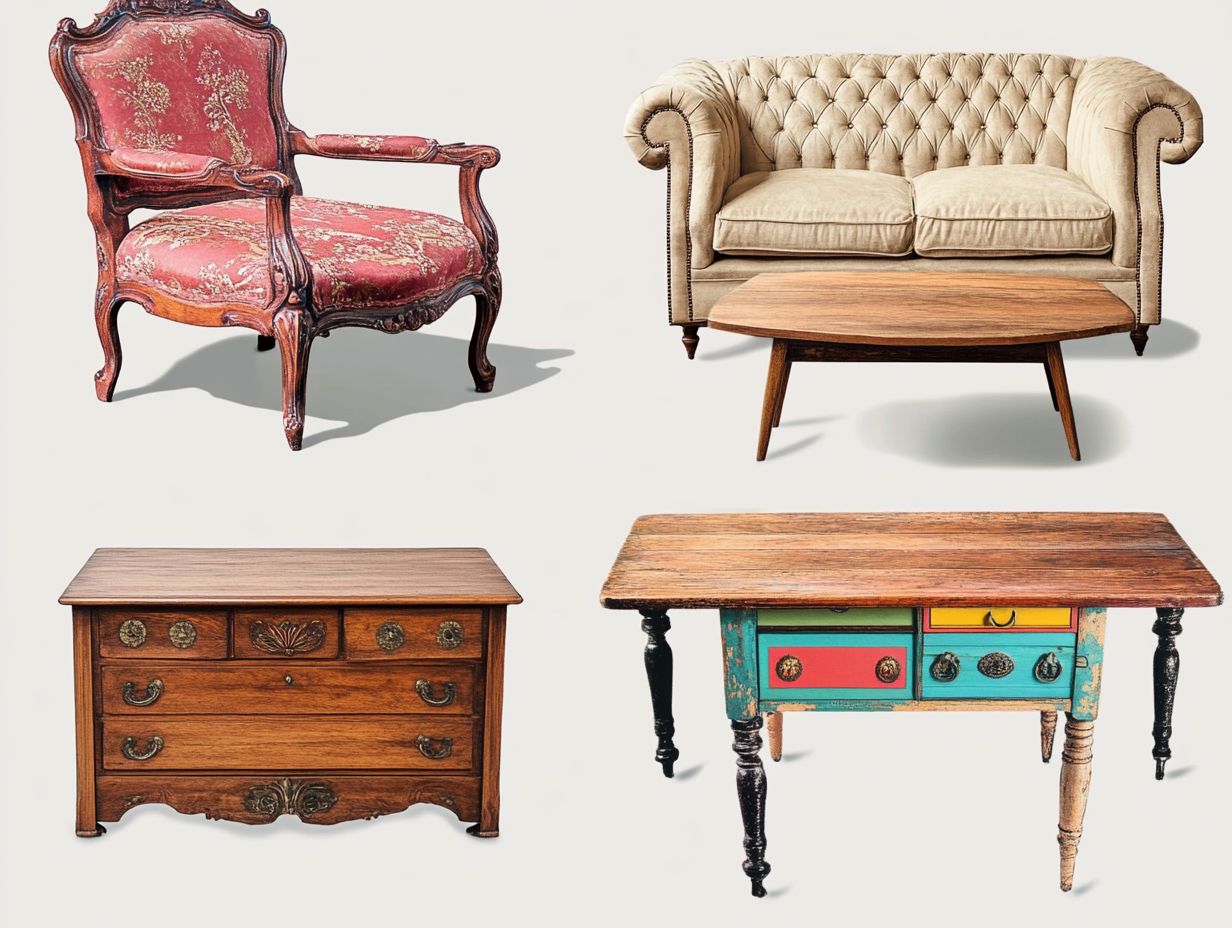
- Invest in vintage furniture for its unique history and timeless design, which can add character and value to any space, especially when considering the historical influence of various furniture movements.
- Look for top brands such as Herman Miller, Knoll, Eames, Broyhill, and Heywood-Wakefield when shopping for vintage furniture, as they exemplify quality and innovative designs.
- When shopping for vintage furniture, pay attention to its type, authenticity, and value. It’s essential to understand furniture appraisal and identification.
1. The History of Vintage Furniture
The history of vintage furniture offers a captivating journey that reveals the evolution of quality through distinct eras, including the Colonial, Victorian, and Arts and Crafts periods. Each of these times showcases unique styles and rich histories that define American furniture.
You ll discover how the intricate ways pieces of wood are joined together by Federal period artisans contrast with the minimalist elegance of the Shaker period. Every era has woven its own thread into an expansive tapestry of aesthetics, reflecting innovations in furniture design.
During the Colonial period, craftsmen like Duncan Phyfe introduced elegant, hand-carved details, infusing European influences into American design. In the Victorian era, opulence took center stage, with notable figures such as Thomas Jefferson a statesman and design connoisseur creating iconic pieces that reflected the Romantic revival.
The Arts and Crafts movement prioritized simplicity and the use of natural materials. This was exemplified by Gustav Stickley, who emphasized handcrafted quality over mass production.
These historical influences have paved the way for modern furniture trends. Today, we emphasize sustainability and quality while embracing minimalist aesthetics that resonate deeply in the current design ethos.
2. Why Invest in Vintage Furniture?
Investing in vintage furniture provides you with not only aesthetic appeal but also significant antique value and unique quality that modern pieces often lack. This makes it a savvy choice for both collectors and homeowners eager to enrich their spaces with a touch of history.
These timeless pieces tend to appreciate in value over time, offering you the delightful prospect of both enjoyment and potential financial gain. Imagine a distinctive vintage chair or an ornate side table in your room, infused with a sense of history that sparks engaging conversations about its unique story.
The durability that accompanies quality ensures these treasures withstand the test of time. This is in stark contrast to some contemporary alternatives that may wear out quickly. By understanding furniture appraisal and market trends, you empower yourself to make informed investments, allowing you to curate a collection that elevates your home design and establishes a profound connection with the decorative arts.
3. How to Identify Quality Vintage Furniture
Identifying quality vintage furniture requires understanding key characteristics that define true craftsmanship. This includes joinery techniques, materials, and overall construction quality. With this knowledge, collectors and enthusiasts like you can appreciate the authentic charm of antique pieces.
Attention to detail is very important. Look for dovetail joints, which showcase superior woodworking skills. Assess the materials used solid hardwood always outshines particleboard in richness and durability. Stylistic elements, like hand-carved details and the finish, influence a piece’s value significantly.
Understanding the provenance, or history of ownership, adds depth to the narrative and enhances its appeal to potential buyers. For an accurate furniture appraisal, consult reputable experts who can verify authenticity. They ll consider factors such as brand stamps, maker s marks, and any inherited documentation, ensuring your investment retains genuine value.
4. Top 5 Vintage Furniture Brands
In the vintage furniture world, some brands truly shine for their exceptional contributions to design and quality craftsmanship. Among these, Herman Miller and Knoll stand out for their innovative designs that shape modern aesthetics.
Founded in 1923, Herman Miller is a trailblazer known for its groundbreaking designs that excite furniture lovers. The brand has earned acclaim for iconic pieces like the Eames Lounge Chair and the Aeron Chair. Both pieces exemplify a flawless fusion of function and style.
Similarly, Knoll, established in the 1930s, has carved out its legacy through a commitment to high-quality materials and sleek lines. Timeless creations like the Barcelona chair, designed by Ludwig Mies van der Rohe, reflect this dedication to excellence.
The impact of designers like Charles and Ray Eames is profound. Their visionary approach not only redefined furniture aesthetics but also laid the groundwork for a movement valuing simplicity, comfort, and creative expression.
1. Herman Miller
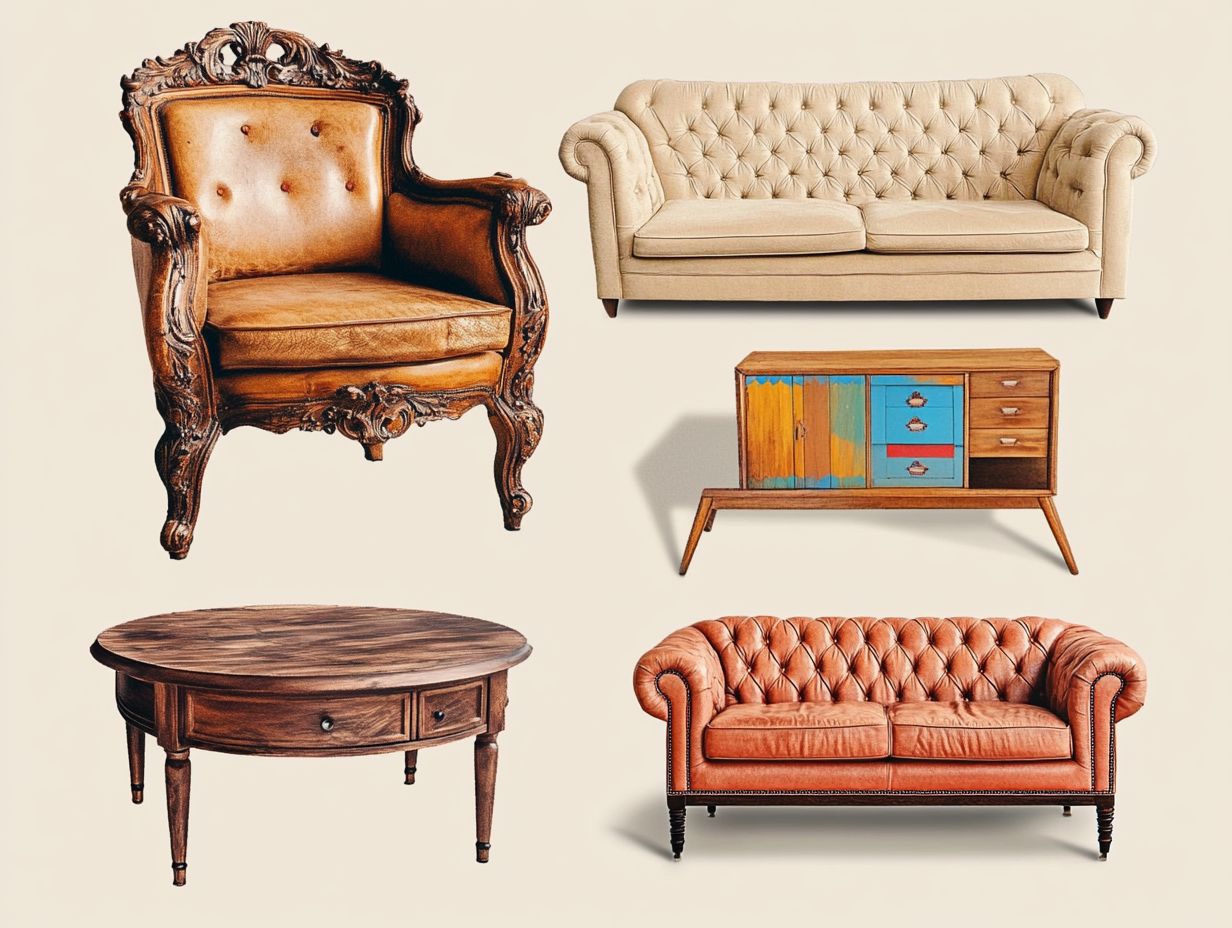
Herman Miller stands as a beacon of modern furniture. It is celebrated for its innovative designs and collaborations with esteemed American designers, setting the gold standard for quality and functionality in the industry.
Founded in 1905, the brand symbolizes progressive design and sustainability. You ll find iconic pieces like the Eames Lounge Chair and the Aeron Chair within its collection. Each exemplifies style and revolutionizes your understanding of comfort and utility in living and working spaces.
This influential brand has shaped mid-century modern aesthetics, encouraging contemporary designers to blend creativity with practicality. Collectors and enthusiasts treasure these timeless pieces, ensuring they remain coveted additions to vintage furniture collections for generations.
2. Knoll
Knoll has positioned itself as a frontrunner in furniture design. It is celebrated for its commitment to quality craftsmanship and its role in advancing modernist movements through collaborations with renowned American designers.
The brand boasts a rich history filled with iconic pieces, such as the Barcelona chair and the Tulip chair by Eero Saarinen. Both masterpieces exemplify clean lines and functional elegance.
Through partnerships with modernist visionaries, Knoll has shaped the aesthetic landscape of the mid-20th century and laid the foundation for contemporary design principles prioritizing form and function. This enduring legacy resonates with today s furniture designers, inspiring them to embody simplicity and innovation in every piece they craft.
3. Eames
Charles and Ray Eames are iconic figures in vintage furniture, known for their groundbreaking designs that mix functionality with aesthetic appeal, leaving a lasting impact on modern furniture design.
Their most remarkable creation, the Eames Lounge Chair, highlights their focus on comfort and innovative materials. This masterpiece shows how form and function can work together beautifully. It has become a staple in mid-century modern homes and set a standard for contemporary furniture design, inspiring many designers over the years.
Their influence extends beyond individual pieces; it influences trends in minimalist design, comfort-focused furniture, and eclectic vintage styles. Their visionary approach is still shaping how we furnish our spaces today, fostering appreciation for diverse furniture styles and historical influences.
4. Broyhill
Broyhill is a key player in the vintage furniture market, celebrated for its strong commitment to quality craftsmanship and designs that reflect American aesthetics.
Founded in 1926, this brand has carved out a niche by blending functionality with timeless style, creating pieces that are both practical and visually stunning. Their design philosophy emphasizes simplicity and elegance, showcasing clean lines and organic forms inspired by the mid-century modern movement.
Signature collections, like Brasilia, are must-haves in vintage furniture circles, known for their unique architectural details and rich wood finishes. Broyhill’s innovative designs and commitment to quality have greatly influenced mid-century American furniture trends, leaving a legacy that still resonates in contemporary styles.
5. Heywood-Wakefield
Heywood-Wakefield sets itself apart in vintage furniture with unique designs and exceptional craftsmanship, capturing the essence of American furniture styles from the mid-20th century.
The brand’s innovative approach combines functional beauty with a touch of modernity, resonating profoundly with homeowners. Notable pieces, like the iconic blonde wood dining sets and streamlined bedroom furniture, showcase the minimalist yet refined aesthetics of the era. These designs reflect cultural shifts and set trends that continue to impact contemporary markets.
When you explore mid-century styles, you’ll see that Heywood-Wakefield’s contributions to furniture design play a vital role in promoting appreciation for vintage pieces, elevating them to timeless classics loved by a new generation. If you’re interested in these styles, be sure to check out what to look for when buying vintage furniture.
What to Look for When Shopping for Vintage Furniture?
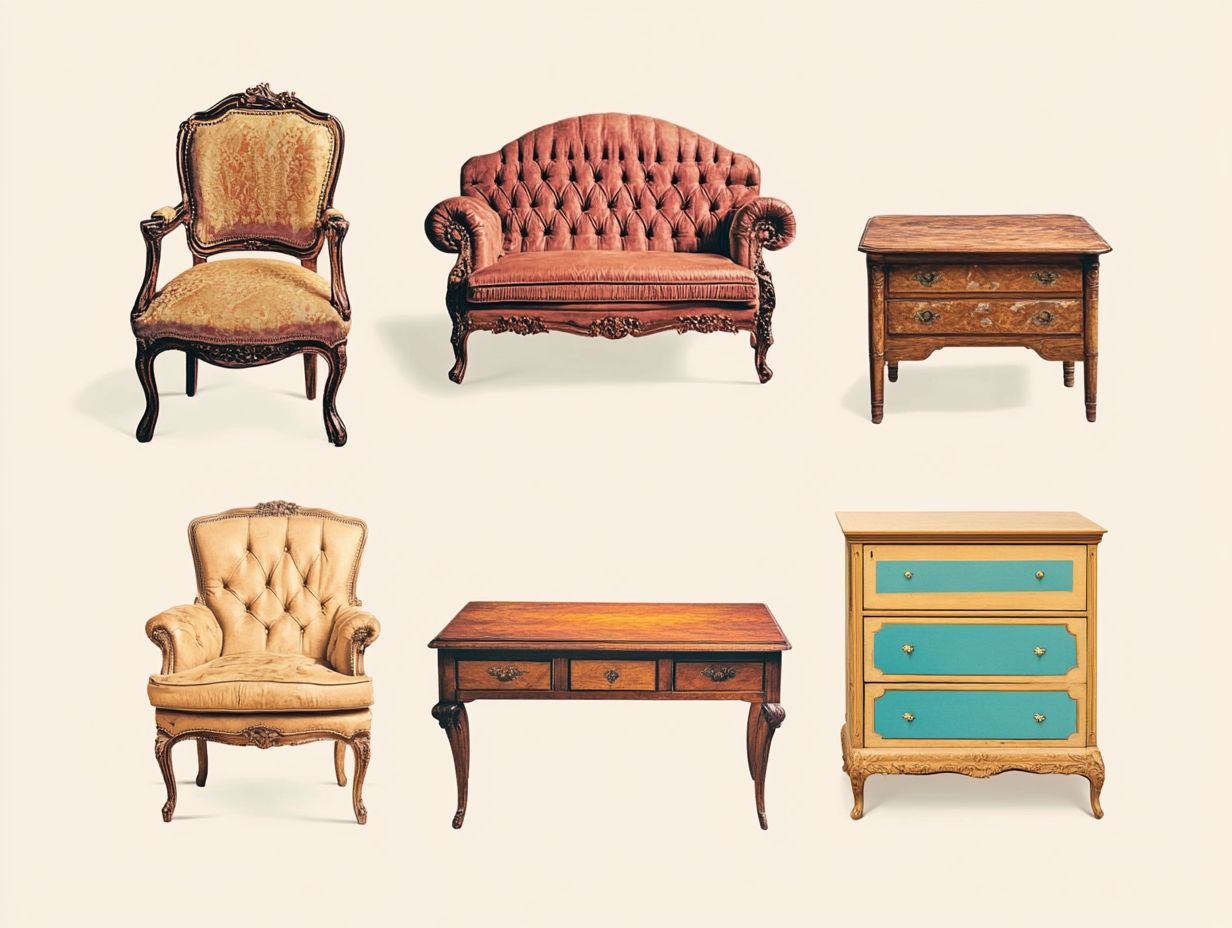
When you’re searching for vintage furniture, consider factors like materials, craftsmanship, and aesthetic appeal to make wise investments in quality pieces. This thoughtful approach helps you discover unique treasures while deepening your understanding of their history.
Start by examining the materials; solid woods like oak or walnut typically indicate durability and value. Inferior materials may suggest a lack of longevity. Next, focus on craftsmanship look for signs of handwork, such as dovetail joints or intricate carvings, which add an artisanal touch and increase desirability.
Familiarize yourself with iconic design features specific to different eras to accurately assess a piece s value. However, tread carefully; avoid overly glossy finishes or repairs that compromise the original integrity, as these can lead to unexpected depreciation.
Don t miss out on finding unique vintage treasures that could elevate your space! What vintage pieces have caught your eye recently?
What Are the Common Types of Vintage Furniture?
Vintage furniture embodies a captivating array of styles from various historical periods, including Colonial, Victorian, Arts and Crafts, and Shaker. Each style radiates its own unique characteristics and aesthetic values.
Take Colonial furniture, for instance. Its simplicity and functionality reflect the Puritanical values of the settlers, offering a sense of grounded elegance.
Victorian furniture dazzles with intricate designs and luxurious materials, a true testament to the era’s opulence and meticulous attention to detail.
The Arts and Crafts movement emphasized authenticity, craftsmanship, and natural materials, striving to counter the effects of industrialization.
Shaker furniture features a minimalist design and practicality, embodying principles of utility and humility.
These diverse styles not only elevate the visual allure of vintage collections but also weave together the historical narratives and cultural influences that shaped their creation.
How Can One Determine the Authenticity of Vintage Furniture?
Determining the authenticity of vintage furniture requires careful observation and a solid understanding of furniture identification markers, historical context, and the antique market.
Start by examining construction techniques. Look closely at joinery and materials, as these details can reveal the era and craftsmanship behind the piece.
Don’t overlook any labels attached to the furniture; they often hold vital information about the manufacturer and production date.
Tracing the history of ownership, or provenance, can provide significant insights into authenticity and overall value.
Consider enlisting the help of a professional furniture appraiser. Their expert evaluation can guide you in making informed decisions and help you avoid costly mistakes.
What Are the Most Valuable Pieces from These Brands?
The most invaluable treasures from top vintage furniture brands exemplify exceptional craftsmanship and innovative design, often holding considerable antique value in today s marketplace.
Among these, iconic chairs from Eames grab attention with their remarkable blend of comfort and modern aesthetics.
Mid-century dining tables from Knoll not only showcase superior materials but also radiate a timeless elegance.
Factors such as the brand’s historical significance, rarity, and the quality of materials used play crucial roles in determining the value of these exquisite items.
Pieces with a rich history or documentation of their origin can command even higher prices. Enthusiasts and collectors actively seek out these rare finds, enriching their spaces and investing in pieces that transcend mere functionality.
These treasured items provide a sense of artistry and heritage.
How Can One Care for and Maintain Vintage Furniture?
Keep your vintage furniture stunning by caring for it right! This requires specific methods tailored to the unique materials and styles of each piece.
Understand the distinctive characteristics of materials, such as the intricate grains of wood or the delicate nature of silk upholstery.
Solid wood pieces benefit from regular conditioning with oils to prevent drying and cracking.
Upholstered furniture calls for gentler, specialized cleaners to protect delicate fabrics.
Stay informed about current furniture trends to develop suitable maintenance routines, ensuring these cherished items not only survive but thrive amid evolving aesthetics.
Frequently Asked Questions
Here are some common questions about vintage furniture.
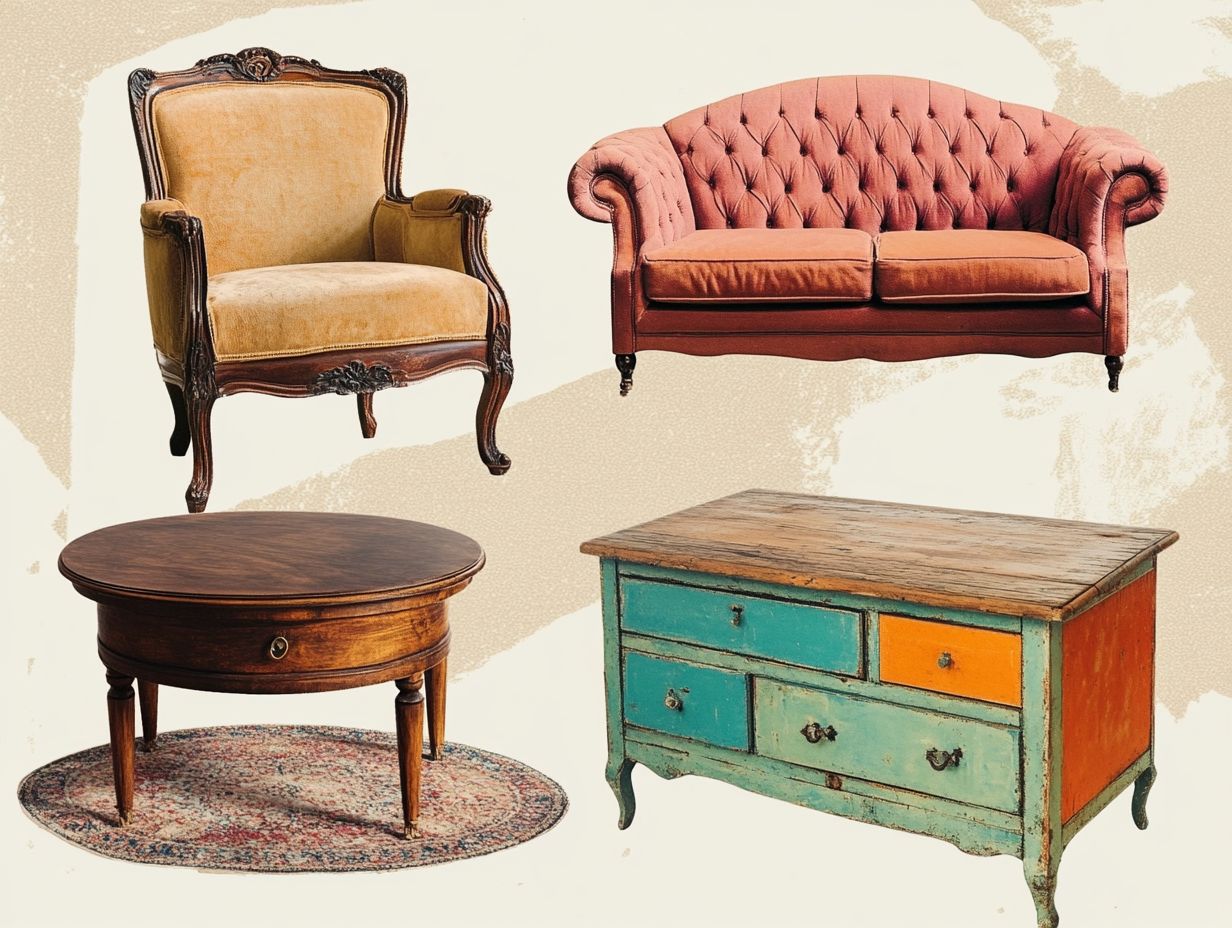
What are the top 5 vintage furniture brands to look for?
The top 5 vintage furniture brands to look for are Herman Miller, Eames, Knoll, Broyhill, and Heywood Wakefield.
Act now to protect your prized vintage pieces!
What makes Herman Miller a top vintage furniture brand?
Herman Miller offers amazing furniture from the 1950s and 60s. Their craftsmanship is exceptional and loved by many.
Why is Eames considered a top vintage furniture brand?
Eames furniture features innovative designs that still catch the eye today. It’s highly sought after by collectors and enthusiasts alike.
What sets Knoll apart as a top vintage furniture brand?
Knoll creates timeless and functional pieces. They are designed by famous architects and designers, making them truly special.
Why is Broyhill a top vintage furniture brand?
Broyhill is celebrated for its sturdy wood construction. Their classic designs have remained popular over the years.
What makes Heywood Wakefield a top vintage furniture brand?
Heywood Wakefield is famous for its stunning mid-century modern styles. Their blonde wood pieces are particularly popular.

